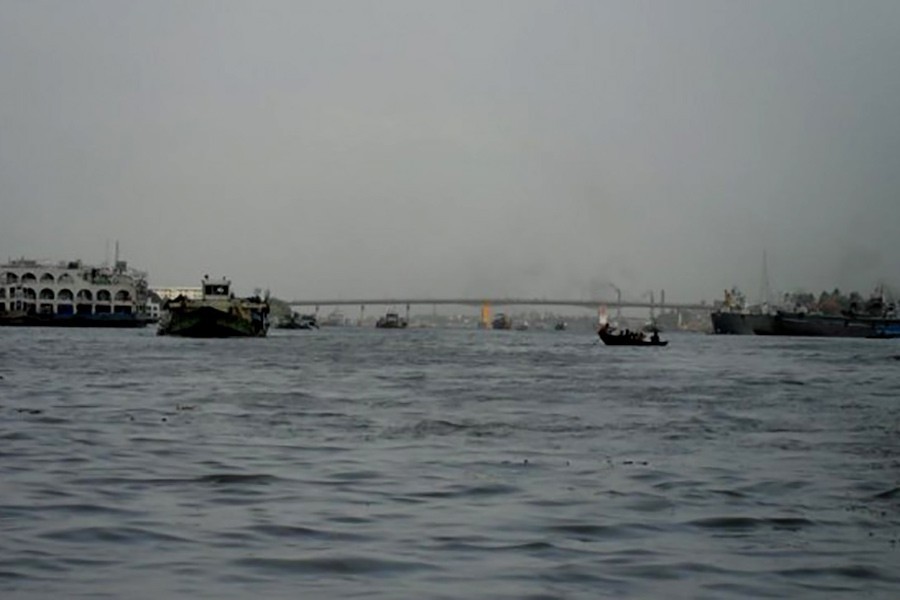The eviction drive carried tenaciously to recover the rivers around the capital city has largely paid good dividends. Without a strong political will, this would have been impossible. Buildings from two-storey to seven or eight-storey were demolished at several points on the Buriganga and Turag banks. Clearly, the Bangladesh Inland Water Transport Authority (BIWTA) has proved that it means business this time. Under the codename Delta Plan, this time the eviction drive has been far wider in scope and range. Use of political clouts to save illegally built structures was of no help. But there is an uncanny silence over the fate of a jetty built and used by one of the regular service outfits.
That the urgency of saving the rivers girdling the city is of the 'now or never' nature, should not go missing at any point. Of the four rivers, the Buriganga and the Balu are worse off in terms of encroachment but so far as pollution is concerned, they are almost equally suffering except the Sitalakkhya. Due to encroachment, all the rivers' channels have shrunk precariously but none more so than the Balu. Of the 36 kilometre length of this river, 22 kilometres have lost navigability because of land-filling and construction of illegal structures. The Turag perhaps follows it a little behind. What is important to know if the drive has targeted those structures for removal and free the river from such occupation. It is yet to be clear, if the eviction drive followed by capital dredging can help the rivers recover their channels and flows.
At the culmination of the eviction drive on the Buriganga and the Balu, an anti-pollution drive was launched on Wednesday, April 4 last. The job at hand is no less daunting than freeing the rivers from encroachers. As many as 185 drains release 50,000 metric tonnes of effluent and solid waste into the rivers. Now that the tanneries have been shifted to Savar from Hazaribagh, the expectation was that the level of pollution would come down tolerably. It has not happened at all. A report claims that tannery effluent and sewage contribute to 60 per cent of the river pollution. Industrial waste and effluent contribute to 30 per cent and the rest 10 per cent has different other sources. Of such sources, burnt fuel oil and lubricant thrown out of launches and other mechanised vessels have a significant contribution.
The fact is that disposal of waste and effluent cannot be avoided. But the important thing is to do so safely. Technology is available for treatment of waste and effluent scientifically. Unfortunately, factories and industries do not follow the rules and regulations for environmentally friendly disposal of highly polluting waste matters. The much touted central effluent treatment plant at the tannery park in Savar has been malfunctioning from the day one. Thus the blame game played by the tannery owners and the administration has taken a new dimension with the Chinese company reportedly reneging on its promise. The public have no knowledge of what has actually happened there. Consequently, the Dhaleswari instead of the Buriganga has become the dumping receptacle of tannery effluent.
There are almost a quarter of a million of factories and industries around the city. Unsurprisingly, 99 per cent of these units have no treatment plants to treat liquid waste. Chromium, nitrate, lead, zinc and mercury contents have not only turned the water of the Buriganga unfit for fish but also for any living organism to survive. So the overriding need is to plug the releasing points of the drains that carry industrial and other poisonous waste -no matter if in liquid or solid form -into the river waters.
The shipping secretary, however, did not sound very tough and serious about the mission the authorities were about to embark on. Primarily the objective was to launch an awareness campaign in order to deter people from polluting the river. It is anyone's guess how such campaigns end up. However, the secretary claims that the next step would be to discuss the sources of pollution at a high level committee headed by the local government, rural development and cooperatives minister.
Sure enough, the laid-back approach does not go well with the seriousness with which the eviction drive was carried out. The polluting factories and industries have either to be relocated or asked to set up their individual or joint effluent treatment plants. Even if this proves beyond their capacities, the government should make fund available for such facilities with opportunities for repayment of loan over a reasonable period. It has to be realised that if the rivers survive, the capital will survive. The same is true for the country as well. Rivers are the lifelines of this capital as well as the country.
A study has found that rivers are dying as a result of outrageous human intervention. Great dams or water barrage may look like providing some advantages temporarily but in the long run they become the sources of sorrows for people. Concerned here are only four rivers if the capital's sustainability is to be ensured. It should not be a big ask to save these rivers from encroachment and pollution. The task has to be accomplished in the interest of the capital city or time may come soon when abandonment of this already unliveable megalopolis will remain the only option.


